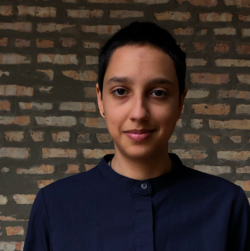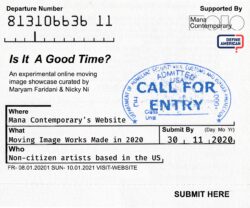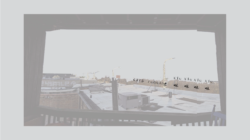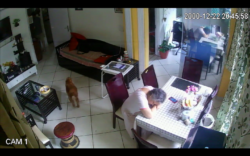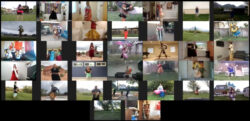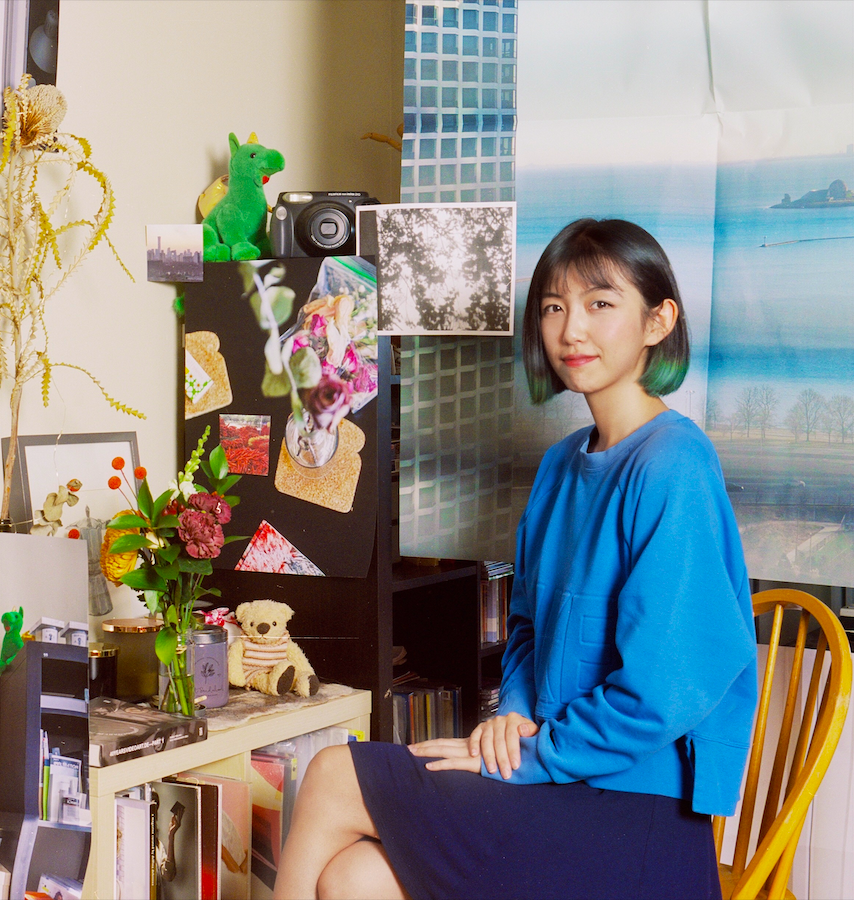
Pecha Kucha notes – Nicky Ni
#An Internet TV Experiment #Is It A Good Time? #Nicky Ni #Pecha KuchaOn April 22, 2021, we were delighted with our first members’ PechaKucha. Five members were chosen through an open call to discuss their current and recent curatorial projects in the form of Pecha Kucha presentations: 20 slides are presented while a presenter has 20 seconds to comment on each slide, for a total presentation of 6 minutes and 40 seconds.
In our blog section, you can now follow the selection of three contributions, finishing with Nicky Ni and her project “An Internet TV Experiment: Is It A Good Time?” at Mana Contemporary.
An Internet TV Experiment: Is It A Good Time? at Mana Contemporary
Written by Nicky Ni with contributions from Maryam Faridani
April 22nd. 2021, Pecha Kucha
Is It A Good Time? was a three-day screening on Mana Contemporary’s website, co-curated by Maryam Faridani and myself. The screening featured works by 33 artists who were non-US-citizens from all over the world, and were residing in the United States. Is It A Good Time? went live at midnight on March 5, 2021 and was streamed nonstop for 72 hours.
In this blog entry, I’m going to walk you through how this project came about, highlight some of the behind-the-scenes thought processes, and credit everyone who was involved. But first and foremost, I would like to introduce my friend, co-curator and artist Maryam Faridani. An alumna of SAIC like myself, Maryam is originally from Iran and received an MFA in Performance in 2019. As an artist, Maryam is interested in using moving images to explore the relationship between technology and its social conditions.
[1. Maryam Headshot. Credit line: Maryam Faridani. Image courtesy of the artist.]
On a fine August day in 2020, when Maryam and I met in person for the first time since lockdown began, we sat by the shore of Lake Michigan with our feet almost touching the water. The vast and serene cerulean blue couldn’t quite ease our minds: we spent the entire afternoon resonating with each other in our anxiety as recent graduates who were still recovering from grad-school purgatory, and as art practitioners who were furious about how large art institutions responded to the pandemic. We also had shared experience as “resident aliens,” trapped in an uncertainty exacerbated by the Trump administration that, from the very beginning, framed the pandemic as an immigration issue. Meanwhile, every American was experiencing lockdown for the first time, communicating online or on the phone with their families and friends from different time zones, panicking about job security or the lack of mobility. But we knew in our hearts that these experiences are what noncitizens like us have to cope with on a regular basis.
Additionally, we expressed our shared frustration with the abundant yet exhausting online programs we had seen until then. Lockdown has propelled arts organizations to carry on programming in virtual formats, and thanks to the internet, we could access events that were happening all over the world simply from our computer screens. But this saturation of information was overwhelming, coupled with our entirely new online habits of viewing moving image: we would put Zoom talks on in the background while making coffee, starting and pausing videos liberally. We would also bookmark unfinished videos, not knowing when we would lose access to those links again.
At the time, Maryam was looking for a project to fulfill her year-long immigrant artist fellowship with Define American; I was simply looking for things to do to stay away from “CoviDepression.” We started to cook some ideas for our event, with two objectives in mind, the first was to provide an opportunity for emerging noncitizen artists to exhibit their work, and share their experiences as individuals bearing an extra burden due to the pandemic. Our second objective was that the format of this event should highlight some of the online experiences and habits that were shared collectively, and be stress-free for every participant. Audience members should not be obligated to watch the full screening; they should be able to tune in, tune out, or leave the video running in the background. Inspired by the old-fashioned linear TV channel that broadcasts 24/7, we envisioned that our online screening would stream continuously for 72 hours on repeat, like an “internet TV.”
[2. CFE Poster. Credit line: Poster designed by Maryam Faridani.]
In November, we released an open call that welcomed all noncitizen artists residing in the United States to submit a piece of work using moving image. The guidelines stated the work should be under 20 minutes in length, and should have been completed in 2020. We also accepted spark art works such as GIFs, and works in progress because we knew that 2020 was a year when productivity plummeted. We received over 80 qualified submissions, and had two guest judges who helped us review and select all the submissions. The judges were New York-based Israeli artist and filmmaker Orr Menirom, and Greek multidisciplinary artist and educator Angeliki Tsoli. The panel selected artworks not only based on quality, but also on how well they addressed timely matters and immigrant experiences. Additionally, we were particularly interested in works that formally spoke to the internet environment and the digital devices that were instrumental in our daily communication.
[3. Jiaqi Zhang. Credit line: Jiaqi Zhang, still from Apartment Door: The Pathetic Boundary between Nature and Non-nature, 2020. Digital format, color, with sound, 1:57 mins.]
The accepted videos were curated into thematic programs. To name a few, “Quarantine Diaries” exhibited short and intimate videos made under the stay-at-home order. For instance, in Apartment Door: The Pathetic Boundary between Nature and Non-Nature (2020), Chinese artist Jiaqi Zhang wittily uses the lifelike voice of an AI text-to-speech persona to read out an onomatopoeic poem that describes the banal scenery outside her apartment door. Another category, “Home Tapes,” revolved around the themes of family and memory. In the work, Promise Me (2020), artist Cheryl Mukerji incorporated footage from a live surveillance camera at her home in India. The internet device was originally installed to watch their sick dog. After the dog passed away, no one took the camera down and she started to watch her mother occasionally from New York.
[4. Cheryl Mukerji. Credit line: Cheryl Mukerji, still from Promise Me, 2020. Digital format, color, with sound, 7:37 mins.]
In another category, short and episodic videos or GIFs interwove with other thematic, hour-long programs. “Breaking News,” for example, was made of videos that parody the format of news. We curated programs suitable to watch at a particular time of day: a meditative, durational performance for the afternoons; trippy and hypnotizing digital works for the evenings. Additionally, we created a dance category to reminisce about the party scenes and night life that we all missed. In Dance for Our Departed (2020), Mexican artist Jorge Rojas brought together a multicultural group of Native American, Polynesian, African, Asian, and Aztec dancers and invited them to dance via Zoom. The work attempts to mourn the deaths while suggesting dancing as a means of healing.
[5. Jorge Rojas. Credit line: Jorge Rojas, still from Dance for Our Departed, 2020. Digital format, color, with sound, 11:39 mins.]
In order to accommodate audiences of different time zones, so that any time-specific programs could be viewed more-or-less at their designated time of the day, we created a daily screening schedule that served four different time zones in four continents. Our event attracted 1,475 views and had an accumulated viewing time of over 110 hours. Although our application for a grant was unsuccessful, we were able to launch a mini Venmo donation to fundraise for our artists. In the end, every artist and the guest judges were paid, albeit by a small amount. To learn more about Is It A Good Time?, read our Curatorial Statement to find out how our screening was received, and read the review by Newcity.
Nicky Ni
Nicky Ni is a curator and writer living in Chicago, and is originally from Beijing, China. She was co-founder of LITHIUM (2017-2019), a Pilsen-based gallery dedicated to time-based art. LITHIUM then became TNL (aka. The Neu Lithium), an online editorial and curatorial platform for time-based and media art. Additionally, Ni has curated exhibitions or screenings at Conversations at the Edge, Mana Contemporary, Museum of Contemporary Photography, and SITE Galleries, among others. She has written for Chicago Artist Writers and Sixty Inches from Center. Ni graduated with an MA from The School of the Art Institute of Chicago and a BS from Northwestern University, and is originally from Beijing, China. IGs: @mllecolettex @theneulithium
[6. Nicky Ni. Credit line: Photo by Guanyu Xu.]








